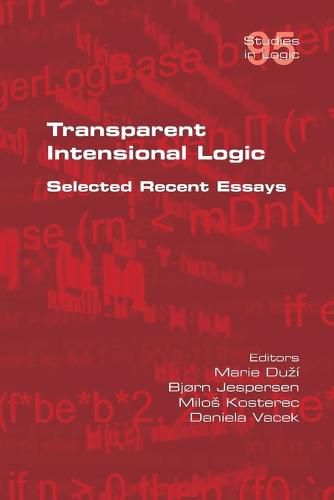Readings Newsletter
Become a Readings Member to make your shopping experience even easier.
Sign in or sign up for free!
You’re not far away from qualifying for FREE standard shipping within Australia
You’ve qualified for FREE standard shipping within Australia
The cart is loading…






This title is printed to order. This book may have been self-published. If so, we cannot guarantee the quality of the content. In the main most books will have gone through the editing process however some may not. We therefore suggest that you be aware of this before ordering this book. If in doubt check either the author or publisher’s details as we are unable to accept any returns unless they are faulty. Please contact us if you have any questions.
Transparent Intensional Logic (TIL) is a fi ne-grained framework with considerable expressive power for a systematic, non-reductionist semantic and logical analysis of (natural) languages. It does not subscribe to model-theoretic semantics, but to an interpreted realist version of procedural semantics. TIL has covered a lot of ground since the publication of the book Procedural Semantics for Hyperintensional Logic by Springer in 2010. The areas that have been covered over the last decade include not least the following topics: existential quantification into various kinds of hyperintensional contexts, property modification, topic and focus articulation, inferences with hyperpropositions, varying degrees of hyperintensional individuation, various rules of the lambda calculus, fictional and religious discourse, and impossibility. This volume contains 27 papers that have been published across a wide range of venues since 2010. The papers are organised into six thematically organized chapters: hyperintensional logic; cohyperintensionality, synonymy and propositional unity; deduction and substitution; logic of intensions: (a) presuppositions, requisites and prerequisites, (b) property modifiers; questions, answers, obligations and norms; fiction, religion, and impossibility. This volume thus provides a detailed survey of the state-of-the-art of the foundations of TIL and its most recent applications.
$9.00 standard shipping within Australia
FREE standard shipping within Australia for orders over $100.00
Express & International shipping calculated at checkout
This title is printed to order. This book may have been self-published. If so, we cannot guarantee the quality of the content. In the main most books will have gone through the editing process however some may not. We therefore suggest that you be aware of this before ordering this book. If in doubt check either the author or publisher’s details as we are unable to accept any returns unless they are faulty. Please contact us if you have any questions.
Transparent Intensional Logic (TIL) is a fi ne-grained framework with considerable expressive power for a systematic, non-reductionist semantic and logical analysis of (natural) languages. It does not subscribe to model-theoretic semantics, but to an interpreted realist version of procedural semantics. TIL has covered a lot of ground since the publication of the book Procedural Semantics for Hyperintensional Logic by Springer in 2010. The areas that have been covered over the last decade include not least the following topics: existential quantification into various kinds of hyperintensional contexts, property modification, topic and focus articulation, inferences with hyperpropositions, varying degrees of hyperintensional individuation, various rules of the lambda calculus, fictional and religious discourse, and impossibility. This volume contains 27 papers that have been published across a wide range of venues since 2010. The papers are organised into six thematically organized chapters: hyperintensional logic; cohyperintensionality, synonymy and propositional unity; deduction and substitution; logic of intensions: (a) presuppositions, requisites and prerequisites, (b) property modifiers; questions, answers, obligations and norms; fiction, religion, and impossibility. This volume thus provides a detailed survey of the state-of-the-art of the foundations of TIL and its most recent applications.